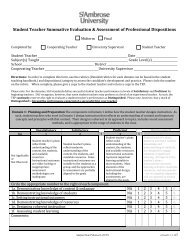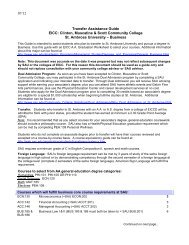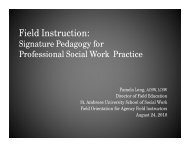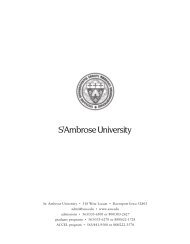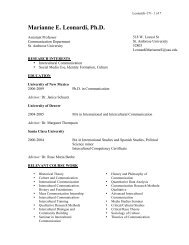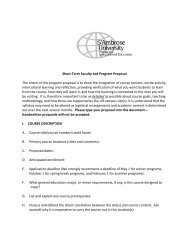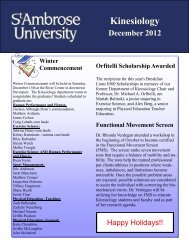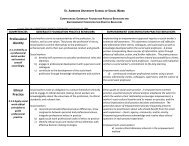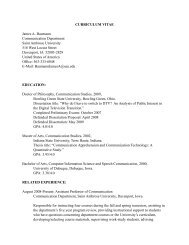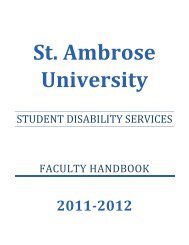St. Ambrose Legends Retire - St. Ambrose University
St. Ambrose Legends Retire - St. Ambrose University
St. Ambrose Legends Retire - St. Ambrose University
You also want an ePaper? Increase the reach of your titles
YUMPU automatically turns print PDFs into web optimized ePapers that Google loves.
Diocesan Heritage<br />
by Ted <strong>St</strong>ephens III ’01, ’04<br />
From humble beginnings as an academy<br />
created by the first bishop of Davenport,<br />
<strong>St</strong>. <strong>Ambrose</strong> has always welcomed<br />
students of all religious faiths, all<br />
ethnic backgrounds and all economic<br />
circumstances.<br />
Fully 130 years after Bishop John<br />
McMullen’s dream began with a first<br />
class of 33 students, <strong>St</strong>. <strong>Ambrose</strong> holds<br />
firm to its distinction as a diocesan university<br />
built upon a foundation of faith,<br />
learning and justice. Our institutional<br />
identity is so deeply informed by our<br />
diocesan heritage and mission of enriching<br />
lives, you can see it in the actions of<br />
our students, faculty, staff and alumni.<br />
But how does a Catholic, diocesan<br />
university like <strong>St</strong>. <strong>Ambrose</strong>—now one<br />
of only 11 in the country—maintain our<br />
diocesan character? How do we grow it?<br />
Perhaps we should look no further<br />
than the new center for the study of Saint<br />
<strong>Ambrose</strong> of Milan. It is an initiative that<br />
at its core best represents the Catholic<br />
Intellectual Tradition that is alive and<br />
flourishing at <strong>St</strong>. <strong>Ambrose</strong> today. It is a<br />
perfect example of professors and students,<br />
alumni and scholars, Catholics<br />
and non-Catholics, asking a full range of<br />
questions, driven by a passionate commitment<br />
to pursue the true definition of what<br />
it is to be Ambrosian. Together, they are<br />
powerfully uncovering a way to live for<br />
the betterment of others.<br />
Consider the life of Saint <strong>Ambrose</strong> of<br />
Milan: Know him and you will find a<br />
man at the very heart of our mission—a<br />
person who wrestled with intellectual,<br />
spiritual, ethical and social issues while<br />
also addressing artistic and physical<br />
aspects of life. He was an active leader,<br />
dedicated to Milan and to his regional<br />
diocese, and a driving force behind imperial<br />
events. He was, as Rev. Robert “Bud”<br />
Grant, PhD, will tell you, both Roman<br />
and Catholic.<br />
“As a diocesan university,” Fr. Grant<br />
wrote recently, “<strong>St</strong>. <strong>Ambrose</strong> offers a<br />
unique charism that distinguishes us from<br />
secular, non-Catholic and Catholic colleges<br />
administered by a religious order<br />
today.”<br />
That is the gift of connectedness to our<br />
patron saint, a man who simply wanted<br />
the best for the people around him. To<br />
celebrate his legacy is to live life as both<br />
a person of the world and a person of the<br />
Church. Saint <strong>Ambrose</strong> showed us that it<br />
is essential for our faith to influence our<br />
work, our service, our politics and our<br />
social relationships. It is something not<br />
just reserved for Sunday mornings, or<br />
whenever it is convenient. Rather, it must<br />
be something that changes the way we do<br />
everything in our lives, everyday.<br />
In other words, it defines our heritage.<br />
15




